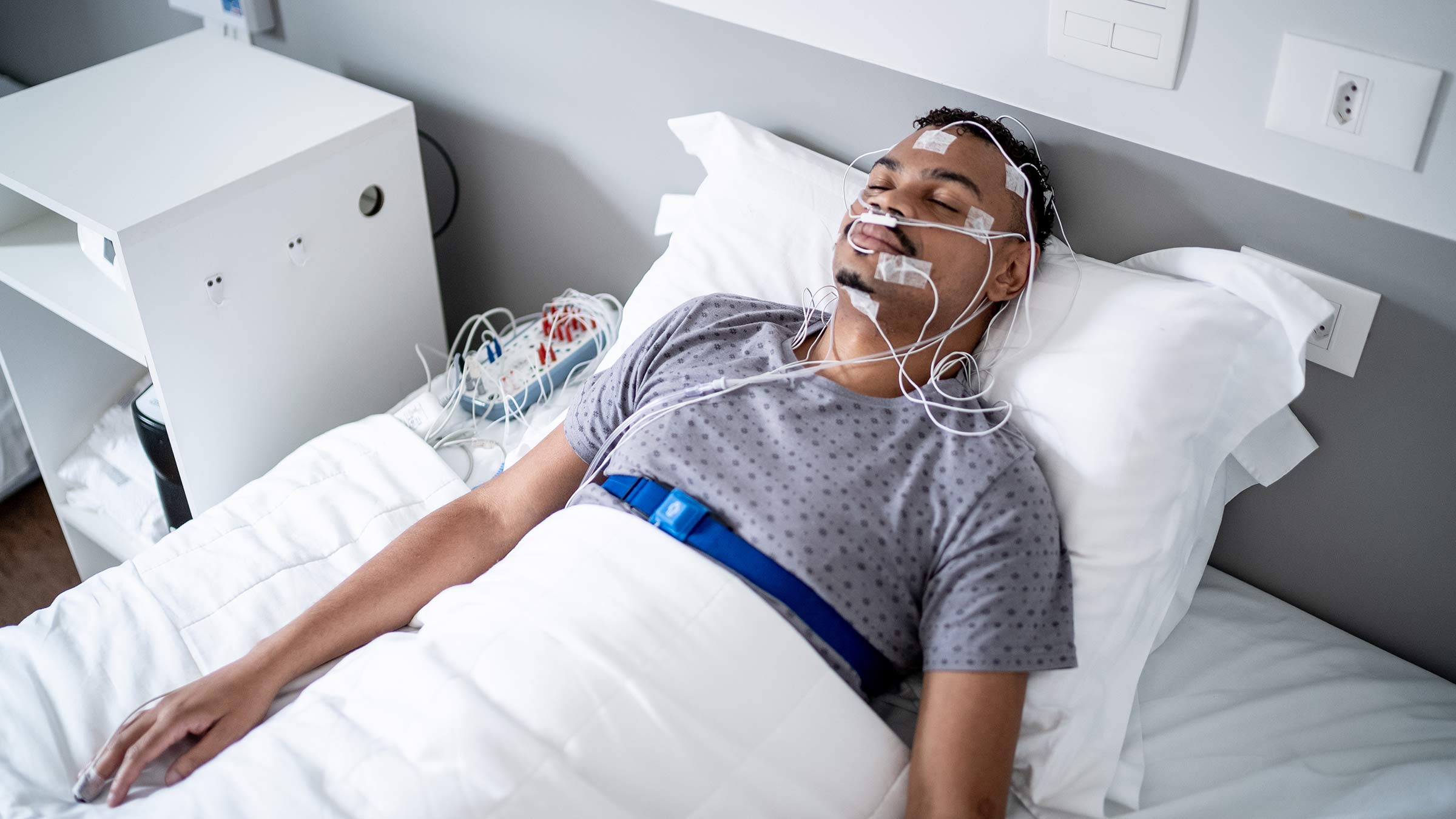
If you consistently wake up tired after sleeping all night or wake up numerous times throughout the night, your doctor may order a sleep study.
Sleep studies, including at-home tests, can help diagnose obstructive sleep apnea, which happens when your airway intermittently closes or narrows during sleep. These closures and narrowings can lead to arousals from sleep and drops in oxygen that can worsen other health issues.
There are a few types of sleep tests that your doctor may recommend:
Home sleep study
This is a study where your doctor sends you home with monitoring equipment to collect data while you sleep in the comfort of your home. There are different types of devices that can be used, but the typical data recorded in a home sleep study are:
- airflow
- breathing effort
- oxygen saturation
In-lab polysomnogram
This is a study done in the sleep lab, where you’re monitored by a sleep technologist who’s in a separate room. More equipment is used and much more data is collected compared to a home sleep test, such as sleep, leg movements and video monitoring.
In-lab polysomnograms also check for obstructive sleep apnea. The test can also identify other breathing disorders, such as:
- Central sleep apnea — where a someone’s brain doesn’t give the signal to breath during sleep
- Hypoventilation — a condition in which someone has shallow breathing in sleep due to weak breathing muscles or difficulty moving air in and out of their lungs during sleep
In-lab polysomnogram also can be useful to evaluate people who have abnormal behaviors during sleep.
How do sleep studies work?
Small pads or patches called electrodes are placed on your head and body with tape or glue. Elastic belts are placed around your midsection to measure your breathing. Your blood oxygen levels are measured with a clip-on oximeter.
The electrodes record lots of data, including:
- Different stages of sleep
- Airflow through your mouth and nose
- Breathing rate and rhythm
- Leg movements
- Oxygen saturation
- Amount of snoring
- Muscle movements
- Chest and belly movements
- Eye movements
- Heart rate
Depending on your symptoms and how you sleep, the test will be tailored to your needs.
Here are a couple scenarios:
- You sleep all night while the equipment records your sleep information.
- If you show signs of sleep apnea during the first half of the night, you may be awakened and asked to wear a mask connected to a continuous positive airway pressure (CPAP) machine. The machine works to increase the air pressure in your throat so your airway is more open when you breathe in during sleep.
There are also a couple other types of tests your sleep doctor may ask for.
In-lab multiple sleep latency test (MSLT)
A multiple sleep latency test is a test done in the sleep lab during the day, and it measures how long it takes you to fall asleep and determines if you enter dream sleep.
You’re asked to take naps every two hours, starting the morning after your nighttime sleep test. Each time, you’re given 20 minutes to fall asleep. If you do fall asleep, you'll be woken up after 15 minutes. Between naps, you’re asked to try to stay awake.
You’ll complete an overnight in a sleep lab and have the multiple sleep latency test the next day. Your sleep patterns are recorded.
In-lab maintenance of wakefulness test (MWT)
This test measures to see if you can stay awake, and it’s run during the day.
What if I can’t fall asleep well during the study? Can you get enough data?
People can have trouble sleeping in the sleep lab with all the cords shooting out of electrodes taped to them. There are people who don’t get a lot of sleep, but many people do.
We would want to have at least six hours of recording time. We like to see REM, or dream sleep, and supine sleep (when you sleep on your back) as that is when breathing issues are worst during sleep.
What to bring to your sleep test
You should pack items that make you feel comfortable and may help you sleep for the test. Ideas include:
- Comfy pajamas
- Nighttime medicines — If the study is to look for sleep disordered breathing, then you can take all your medications as usual. Even if your medications can affect breathing, if it’s a medication you’ll be on long-term, it would be good to see what your breathing is like when taking it. Discuss your medications with your doctor before the test.
- Snacks
- Pillows
- A book to read
What happens after a sleep study?
The study is scored by a sleep technologist and then read by a sleep medicine physician. This should be completed within a week of the study being completed. If the results aren’t conclusive (you didn’t sleep enough), then a repeat study can be considered — perhaps with a sleep aid.
You should consider bringing any questions you have to a follow-up appointment. You may want to ask your doctor the following:
- Did the sleep test show sleep apnea? If so, what type and how severe? What are the treatment options for me?
- If it’s an in-lab sleep study, you can ask the following questions:
- How much did I sleep?
- Did I sleep on my back? (Obstructive sleep apnea is worse on your back, so if you did not have supine or back sleep, the severity of OSA can be underestimated.)
- Did I experience REM sleep? (OSA is worse in REM sleep, and if you didn’t have REM sleep, the presence and severity of OSA can be underestimated.)

Take charge of your sleep
Learn more about the causes of sleep disorders and treatment options available at Ohio State
Take charge today




